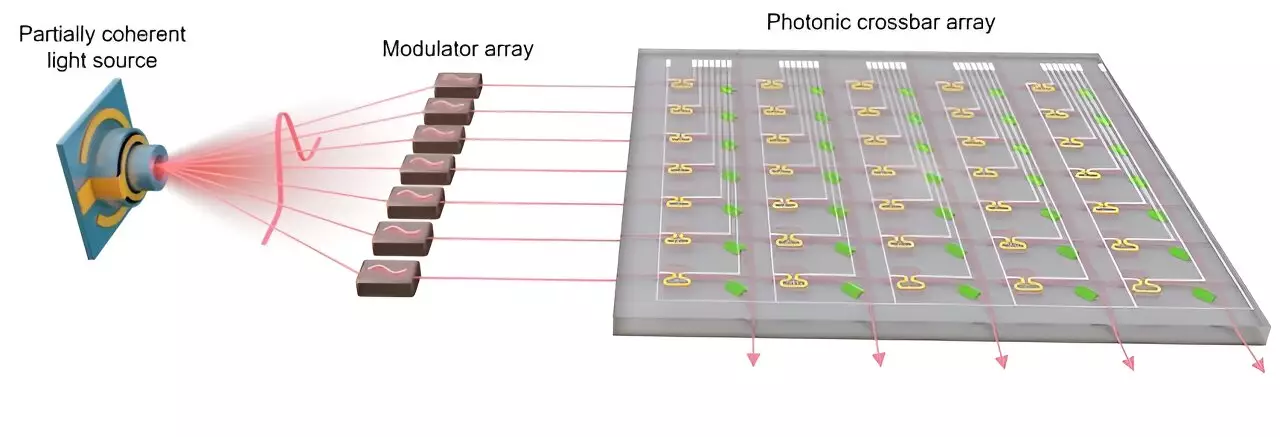In a groundbreaking study published in *Nature*, a team of researchers from the University of Oxford, in collaboration with institutions from Muenster, Heidelberg, and Ghent, has pinpointed a surprising avenue to enhance photonic computing: low-coherence light sources. Traditionally, the pursuit of optical precision has heavily favored high-coherence lasers, renowned for their ability to deliver light in a focused, monochromatic manner. However, this study reveals that simplicity in light source design can yield more substantial computational efficiencies, particularly in the realm of artificial intelligence (AI) technologies powered by photonics.
For years, the engineering of coherent light has served as a foundation for a myriad of applications, from telecommunication protocols to advanced medical imaging. Conventional wisdom dictated that coherent light equated to better performance, as it ensures minimal dispersion of waves over time and space. But the findings of this recent study shake the very premise of optical computing, positioning low-coherence light—often thought of as inferior—as a promising alternative.
Understanding Coherence: A New Perspective
Coherence in light refers to the uniformity of wave phases. High-coherence sources like lasers produce light waves that are highly consistent, fostering enhanced precision in applications such as measurements and imaging. In stark contrast, low-coherence sources, which emit light across a broader spectrum of wavelengths—like sunlight—have been largely dismissed in critical computing contexts.
However, the innovative work from this Oxford-led team illustrates that lower coherence can, under the right circumstances, lead to improved performance in AI computation. This was evidenced by their experiments using a partially coherent light source—a cozy middle ground that utilizes aspects of incoherent light from an erbium-doped fiber amplifier. By splitting and distributing this light across multiple input channels, they employed parallel processing techniques that significantly boosted computational capabilities.
A Leap Forward for AI and Medical Diagnostics
The implications of utilizing partially coherent light are particularly pronounced in the realm of AI accelerators. The research team demonstrated that computing speed could be increased exponentially compared to traditional coherent light setups, a remarkable finding that could propel the advancement of AI technologies well beyond existing parameters.
In their test application, the researchers focused on diagnosing Parkinson’s disease through gait analysis, achieving an impressive accuracy of over 92%. This not only speaks to the technical prowess of using low-coherence light but also highlights its potential to revolutionize crucial medical diagnostics through rapid and efficient processing of vast data sets. A system capable of executing 100 billion operations per second, serving as a benchmark to conduct these analyses, marks a decisive enhancement over previous computational standards.
Cost and Energy-Efficiency Reconsidered
One of the most enticing aspects of this research is the promise of reduced costs and improved energy efficiency in photonic applications. Traditionally, laser systems, being both expensive and energy-intensive, have posed significant barriers to entry for many technologies reliant on optical computing. By advocating the use of low-coherence light sources, the researchers pave the way for more accessible and environmentally friendly technologies that could democratize AI, making it economically viable for diverse sectors ranging from healthcare to education.
Dr. Bowei Dong, the first author on the study, emphasizes the transformative potential of this new approach, noting that the benefits of such “poorer” light sources are not merely marginal but can result in dramatic improvements in operational speeds. Scaling the photonic AI accelerator enables extensive applications beyond healthcare, affecting industries reliant on rapid data processing and analytics.
Future Frontiers in Photonic Computing
As this research era unfolds, the task ahead will center on leveraging these insights beyond just AI applications. Professor Harish Bhaskaran, who led the research and is a co-founder of Salience Labs, acknowledges the looming question: can this innovative use of partially coherent light extend to optical communications, particularly within burgeoning optical interconnect technologies? The potential for such a transition could lead to substantial gains in data transfer rates and overall system resilience.
With this advance, the researchers spark not just curiosity but also excitement about a new frontier in optical computing. By tossing aside long-held beliefs about coherence, they invite the scientific community to reevaluate the tools and techniques devoted to optical innovation. The future may very well belong to those who dare to think differently about light.


Leave a Reply